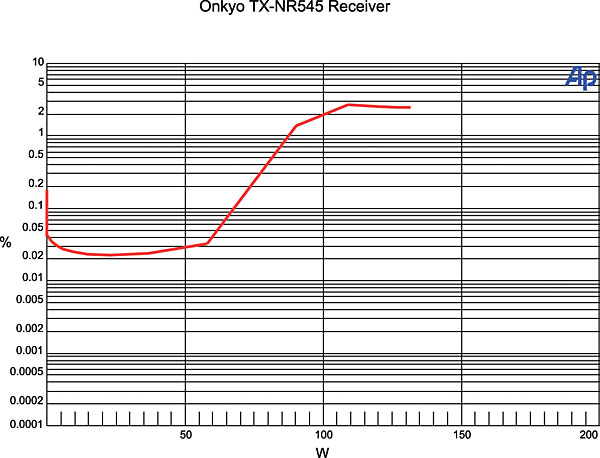- REVIEWS
Displays Electronics 
Speakers Sources 
Other Gear Software - TOP PICKS
- HOW TO
How To Buy 
How To Use 
Tech 101 - BLOGS
- NEWS
- FEATURES
- INSTALLS
Custom Installation - SUBSCRIBE
Onkyo TX-NR545 Atmos-Ready AV Receiver Review Test Bench
Test Bench

This graph shows the TX-NR545’s left channel, from CD input to speaker output with two channels driving 8-ohm loads. Measurements for THD+noise, crosstalk, signal-to-noise ratio, and analog/digital frequency response were all within expected performance parameters. Full details available at soundandvision.com.—MJP
| 0.1% THD | 1.0% THD | |
| 2 Channels Continuously Driven, 8-Ohm Loads | 67.6 watts | 87.6 watts |
| 2 Channels Continuously Driven, 4-Ohm Loads | 89.0 watts | 131.3 watts |
| 5 Channels Continuously Driven, 8-Ohm Loads | 46.5 watts | 61.5 watts |
| 7 Channels Continuously Driven, 8-Ohm Loads | 44.5 watts | 56.0 watts |
The Onkyo does not upconvert; the resolution at its output is the same as the resolution at its input. It will pass a 4K source at an HDMI input to a 4K set.—TJN
|
|
| ||||||||||
| Displays Electronics Speakers | Sources Other Gear Software | Top Picks of the Year Top Picks | Custom Install How To Buy How To Use |
Tech 101
|
Latest News Features Blogs | Resources Subscriptions |
WHERE TECHNOLOGY BECOMES ENTERTAINMENT
 © 2025 Sound&Vision
© 2025 Sound&VisionAVTech Media Americas Inc., USA
All rights reserved




























































